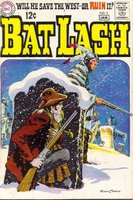The opening story has Tomahawk chasing down a renegade and his band of Indian followers who have robbed a small settlement. The quarry splits up into three different parties to make tracking them down harder. The first band is headed for the forest, where they will be impossible to catch, but Tomahawk has an idea:
He frees the logs and they roll down the hill, blocking the pass so he can capture the first third of the group. When they have been captured, they reveal that an old medicine man had predicted the means of trapping them:
Mysterious predictions like this one are a staple of DC plots; the entertainment comes from seeing how they come true. As usual, there are three predictions the seer made, but the first party refuses to reveal the other two.
A little later they encounter the second group. Caught out in the open they are forced to improvise until the enemy runs out of ammunition:
And thus we learn what the second prediction had been. Tomahawk and Dan locate the old medicine man to find out his third forecast:
And sure enough, when they encounter the last group of the renegade's men, the prediction comes true:
Comments: Solid entertainment. GCD doesn't list the writer, but the art is by longtime Tomahawk stalwart, Fred Ray.
The second story is Tomahawk's Frontier Valet. The basic premise of the story is laid out here:
As you can probably tell from that panel, the gag here is the basic "fish out of water" premise that is very common in TV and movies; The Beverly Hillbillies is a good example. It's not hard to guess that Tomahawk and Dan will find having a valet a very mixed blessing, although one assumes that on at least one occasion he will prove useful.
Word comes of Lord Boswell's whereabouts:
Note the stark simplicity and beauty of that panel. Fred Ray's name doesn't come up often on the list of great artists of the Silver Age, but that's mostly because he wasn't drawing superheroes.
As they set out in search of Lord Boswell, Tomahawk and Dan are captured by the hostile tribe. And, as I predicted:
Terrific characterization there. However, he falls from his horse and accidentally destroys a sacred war-club. The hostiles decide that they must take the trio back to their chief to determine their fate. When they meet the chief, they discover Lord Boswell is there as well. He's apparently lost his memory as he does not recognize them. The chief decrees that they are to die at sunrise.
But Tomahawk escapes, kayos Lord Boswell and disguises himself to look like the English gentleman. This enables him to move freely about the camp and prepare some surprises for the hostile tribe:
They escape with Lord Boswell, who has recovered his memory thanks to that sock on the jaw from Tomahawk.
Comments: A little gem of a story, where everything meshes perfectly.
The finale is the cover story. As shown on the cover, Tomahawk and Dan have been captured by a force of Indians and Redcoats, when Miss Liberty makes her first dramatic appearance:
She frees the buckskin-clad heroes and then diverts the attention of the chasers so that Tomahawk and Dan can make their way into the nearby town of Newton. We learn what has attracted the attention of the British:
We also meet a pretty nurse who's about to journey to the next town with some medicines. Afterwards, she lingers outside the apothecary shop:
And indeed, the British have prepared a trap for them. Fortunately, Miss Liberty and some friends of hers have arranged a surprise:
We learn more about her here, including the need for a secret identity:
The British issue a proclamation that any village harboring Tomahawk and Dan will be razed and its inhabitants driven from the territory. In due course they learn that the heroes are in Wilk's Landing and thus:
But it was all a plan to get the munitions out of the town and to Washington's army:
Comments: Wow, once again terrific characterization; the sacrifice of the townspeople is quite moving.
Overall the Silver Age Tomahawk is not that fondly remembered, due to some of the sillier elements of apes, monsters and weird transformations so common to the time infecting the series. But this issue is superb, with three great stories and excellent art throughout by Ray. In fact, I have no hesitation in dubbing this one of the Silver Age's:




























































